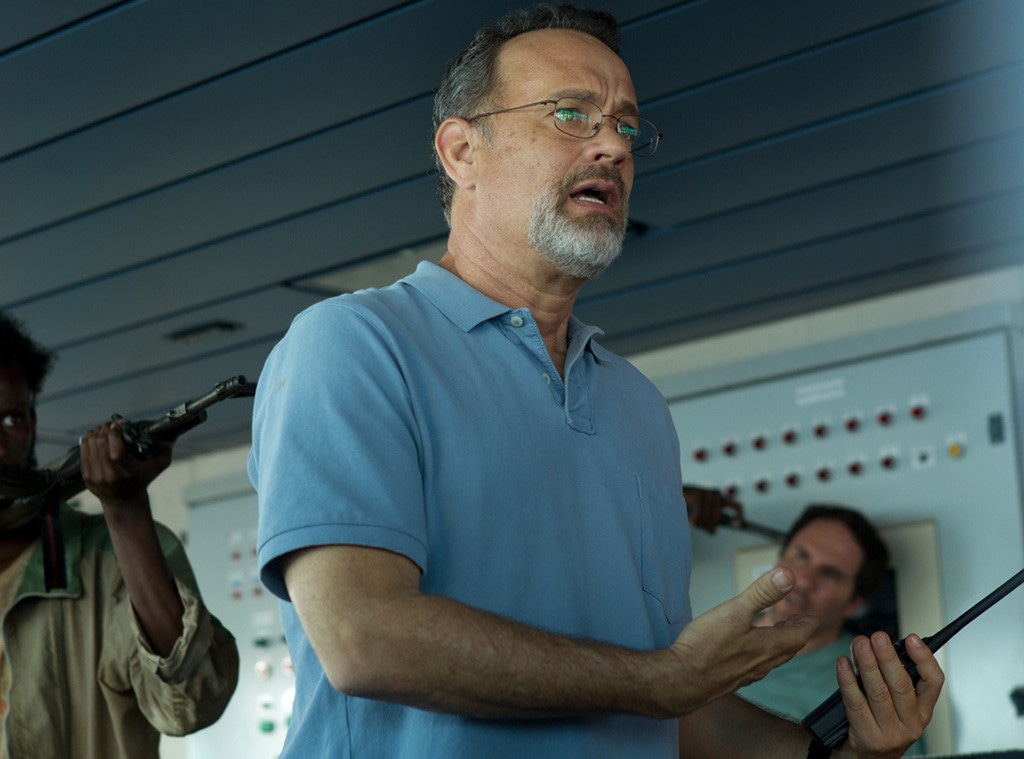 Columbia Pictures
Columbia Pictures Hit the high seas for this high-intensity thriller, based on actual events from 2009. Tom Hanks stars as Captain Richard Phillips, a Vermont family man and commanding officer of the U.S. container ship Maersk Alabama. While transporting commercial cargo and food aid past the Horn of Africa, Phillips and his unarmed Alabama crew are attacked by four Somali pirates, led by Muse (Barkhad Abdi). Phillips tries to negotiate a peaceful financial solution, but the AK-47-wielding hijackers take him hostage in a tiny lifeboat, triggering a major rescue operation by the U.S. Navy. Before you say "aye, aye" to this Captain, get debriefed with classified info:
1) Pack Your Dramamine: Seventy-five percent of Captain Phillips was shot over 60 days on the open water. Director Paul Greengrass (The Bourne Ultimatum, United 93) — a filmmaker known for his urgent, documentary-style approach — wanted to strive for maximum verisimilitude by shooting on a ship that closely resembled the real Maersk Alabama. Securing an available vessel was no mean feat. So when the Maersk Line identified a similar, underused container ship in the Mediterranean, the production moved to Malta to take advantage.
2) Fishing for the Truth: Hanks prepared for his role by visiting with Richard Phillips himself, who wrote the book A Captain's Duty: Somali Pirates, Navy SEALs, and Dangerous Days at Sea. Though the script is largely based on Phillips' account, the filmmakers wanted to expand the story to reflect the pirates' world. They researched Somali piracy, which began in reaction to industrial overfishing — former fishermen hijacked ships as a source of revenue. Like many criminal activities, piracy then evolved into an organized enterprise run by warlords.
3) Ahoy, Ye Newbies: To fill the pirate roles, the filmmakers focused on the U.S.'s largest Somali-American community, in Minneapolis, Minnesota. An open casting call drew more than 1,000 candidates, including first-time actor Abdi, who landed the plum part of pirate captain Muse. Three of Abdi's friends — Faysal Ahmed, Barkhad Abdirahman, and Mahat M. Ali — were cast as his crewmates. To add a level of realism, Greengrass kept the Somali-American actors from meeting Hanks until they shot the scene of the pirates storming the ship's bridge.
4) Pirate Practice Makes Perfect: Prior to filming, the four pirate actors began a rigorous training regimen, comparable to boot camp. They learned how to swim, fight, use guns, handle boats, and work in choppy waves. Their training was crucial for one of the film's most challenging scenes, the taking of the Alabama, which was done without CG effects. The actors had to maneuver a skiff along a moving cargo ship with a tremendous undertow, attach a ladder to the side, and climb aboard, 100 feet above the water.
5) Keeping It Real: The pulse-pounding climax involves multiple helicopters and several Navy ships, including a destroyer that stands in for the USS Bainbridge. The majority of the men seen inside the destroyer's Combat Information Center are real-life officers and seamen, along with two sailors who served aboard the Bainbridge during the 2009 hostage crisis. Navy SEALs are also (literally) dropped into the mix. Aiming again for authenticity, the filmmakers — with the help of a civilian SEAL adviser — enlisted ten former SEALs to play snipers.